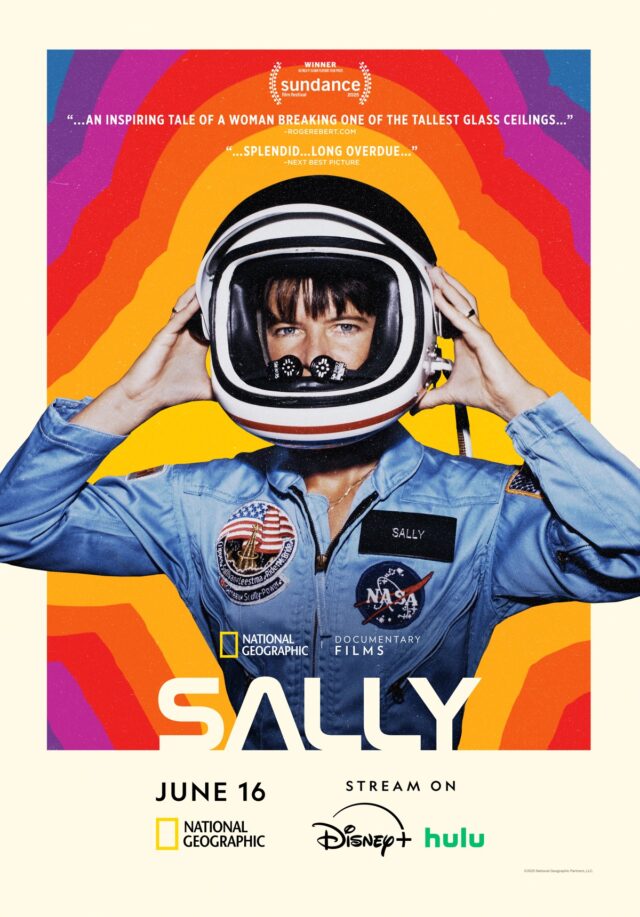Sally Ride's life partner, Tam O’Shaughnessy, tells the full story of this iconic astronaut for the first time.
A recreation of NASA astronaut Sally Ride's iconic name tag during the STS-7 launch. Credit: National Geographic/Parker Hill
"Sally Ride became the first American woman to blast off into space, but beneath her unflappable composure, she carried a secret."
On June 18, 1983, NASA astronaut Sally Ride made history as the first American woman in space aboard the Space Shuttle Challenger. National Geographic is marking the occasion with a new documentary on the astronaut's life: Sally. In addition to revisiting her storied career, the film provides an unprecedented look at the famously private Ride's personal life—notably her nearly 30-year relationship with another woman.
Director Cristina Costantini's prior work includes the 2018 Emmy-nominated National Geographic documentary Science Fair, chronicling nine teenagers' paths to competing in the Intel International Science and Engineering Fair. So perhaps it's not surprising that Costantini is a longtime fan of Ride since childhood. "It was just, if a girl can go to space and do all these things that women aren't supposed to do, maybe I can do big things, too," she told Ars. "I think a lot of women have the exact same reaction. If she can do it, we can do it. As I got older and I learned more about Sally, I realized, wow, she really had a very fine line to walk and she did it so masterfully."
Ride died of pancreatic cancer in 2012, which is when Costantini and much of the rest of the world discovered that the astronaut's business partner, Tam O'Shaughnessy, was also Ride's romantic partner and had been for 27 years. "I thought, oh my God, if NASA was barely ready for women, what was this like?" said Costantini. "What was beneath the story that we had been fed our entire lives of who Sally really was? I wanted to make a film that celebrated the Sally we all knew and also celebrated the Sally we didn't know and complicate her legacy and make her a real person."
It was O'Shaughnessy who approved that 2012 obit, recalling that the week before Ride died, she mentioned her plans to hold a celebration of Ride's life for friends, families, and colleagues. "She really liked the idea and she perked up and got excited and we started planning," O'Shaughnessy told Ars. "Then suddenly I wondered: who am I going to be to the people who don't know that we are a couple? And who am I going to be in the world after you're gone? Sally thought about it for a minute and then she said, 'You decide. Whatever you decide will be the right thing to do.'"
O'Shaughnessy naturally had concerns about how NASA would react to the news, since Ride had carefully hidden that side of her life for decades. "I was worried about not having been completely honest with some of our friends and certainly our colleagues," she said. "But then I just realized Sally was a really honest person, and I am too. So I just decided, that's it. I'm going to be myself and open about our relationship the rest of my life."
The public face
Sally Ride and fellow astronauts, including Kathy Sullivan and Bob Crippen, during training at NASA Johnson Space Center in 1984. NASA
When the producers contacted her about the documentary for National Geographic, and she met Costantini, O'Shaughnessy agreed to be interviewed for the film. "It just all came together. It was the right team at the time," O'Shaughnessy said. "And I felt so comfortable with Cristina when she was interviewing me that I just felt relaxed and just open."
Sally hits all the well-documented major moments in Ride's impressive career: her application and acceptance to NASA's Space Shuttle program, the rigorous training, her promotion to full-fledged astronaut, serving as a ground-based CapCom for two space shuttle flights, and her historic 1983 flight. We also get a sense of what the NASA culture was like for women at that time, with reporters at press conferences asking if she cried whenever things got stressful, the special space makeup kit she was given for her flight, and the infamous oversupply of 100 tampons for a six-day mission.
We also learn of Ride's disillusionment with NASA after the 1986 Challenger disaster that killed several of her good friends and colleagues. She was the only NASA employee to serve on the subsequent Rogers Commission investigation. While physicist Richard Feynman famously demonstrated how the O-rings froze on the cold morning of the fatal launch, after she died, it was revealed that Ride had uncovered this information and passed it along to Feynman via a go-between in order to protect her source. Ride left NASA in 1987 to take up a faculty position, first at Stanford University and then at the University of California, San Diego.
That's the public face of Sally Ride. We also hear about her childhood in Encino, California, her early promise as a tennis player—she met O'Shaughnessy on the tennis circuit as teens, and Ride's first girlfriend was also a fellow tennis player—and her education, culminating in 1978 with a PhD in astrophysics. She married fellow astronaut Steve Hawley in 1982, but that relationship was breaking down when Ride began her affair with O'Shaughnessy in 1985. She and Hawley divorced in 1987; he knew nothing of the affair. Ride eventually co-founded an education and outreach program, Sally Ride Science, with O'Shaughnessy, and the couple co-wrote several children's books about space science
O'Shaughnessy's commentary is especially powerful because of her remarkable willingness to be open, honest, and emotionally vulnerable. "Tam's an incredible storyteller," said Costantini. "She's very fun and very cool to hang out with, but she's a godsend for a documentary filmmaker because she really wanted to be vulnerable and tell a story about a real person. That made all the difference."
For instance, O'Shaughnessy is very frank about how hurt she felt when Ride insisted on keeping their relationship a secret, even after her divorce. The pair nearly broke up over it before working through the difficulty. Part of that tension stemmed from the anti-LGBTQ+ sentiments of the era, a period when the outing of tennis megastar Billie Jean King (who also appears in Sally) led to King losing an estimated $2 million in endorsements.
Ride and O'Shaughnessy also moved in different circles during those crucial years. While she was always guarded, O'Shaughnessy spent time on the women's professional tennis tour, an environment that was far more tolerant and welcoming of same-sex attractions among its players. Ride, by contrast, was a NASA astronaut and bona fide celebrity after her historic flight—a culture that was barely ready to welcome women astronauts, never mind one with a female partner. Add in Ride's natural tendency to extreme privacy and the tension was inevitable.
"I understood that this was her basic nature, and she had a lot to lose, but I didn't like it," said O'Shaughnessy, although love ultimately triumphed. "I wish we could have been more open. I loved her. It would have been fun to share her more, even with some of her friends that she wouldn't let in. She only let in certain people. And once we started the science education company, there was no way. We knew we were dependent on corporate sponsorships. We just decided, 'We've got to hide it.'"
A private life
Tam O'Shaughnessy and Sally Ride in Sydney, Australia in 2004. courtesy of Tam O'Shaughness
Juggling between these two very different aspects of Ride's life posed a challenge for Sally's director. "I really think there are two different films here," said Costantini. "One is that Sally that we all knew, who was almost too well documented. We had to bring in 5,000 reels from the NASA archives and sort through them to find some gems. It was a mountain of footage and a lot of it was labeled as just 'shuttle era' or something very nonspecific. We also had to sound sync it all, since it didn't have sound."
On the private side, she decided to rely on several re-enactments. "There were not very many pictures and not any footage of the two of them together," said Costantini. "So we decided to create our own visual language around that love story that would help illustrate Tam's storytelling in these private moments. It's a careful weave of stepping away from the very public and going into the very private. I love that the story has these big, epic space moments and also these very quiet, intimate moments, the microscopic and the celestial."
"We really made this film for anyone who's ever had to hide part of themselves to get where they want to be, which is, in 2025, a more common experience than ever," said Costantini. "I'm very inspired personally by Tam and Sally's bravery: Sally's bravery to launch on a rocket up into space, Tam's bravery to live as a queer woman during a time when that was not celebrated by mainstream culture. I often think there's a real lack of brave people nowadays. I open the newspaper and think, 'Where did all the brave people go?' Looking into Sally's past, you can see echoes of some of the same struggles that we're facing today.
"I hope that the film will give people some optimism that things can get better, but also to remind them that things can get worse and that these rights that we do have now are not guaranteed," Costantini continued. "We're standing on the shoulders of women like Sally and Tam, and we've got to fight to defend the progress that these people have made for us. So I think this film is more relevant than ever."
One of the film's most powerful moments is a re-enactment of Ride and O'Shaughnessy slow-dancing to Neil Young's "Harvest Moon" just before Ride's death, with O'Shaughnessy supporting her weakened partner through the steps. It's the Sally Ride only O'Shaughnessy had the privilege to know. "Sally wasn't perfect, and she was certainly not open about being a queer woman," said O'Shaughnessy. "But she had such integrity, and she lived her life exactly the way she wanted to live it. Sally would never let anyone tell her what she should do with her life. I think that's a powerful message to be true to yourself."
As O'Shaughnessy says at the end of Sally, "We were brave enough to love each other."
Sally is now streaming on Hulu and Disney+.
Credit:
National Geographic

Jennifer is a senior writer at Ars Technica with a particular focus on where science meets culture, covering everything from physics and related interdisciplinary topics to her favorite films and TV series. Jennifer lives in Baltimore with her spouse, physicist Sean M. Carroll, and their two cats, Ariel and Caliban.











 English (US) ·
English (US) ·